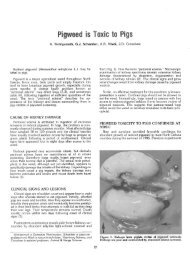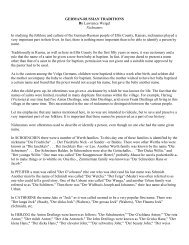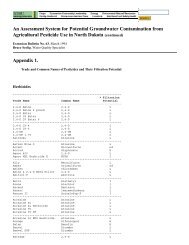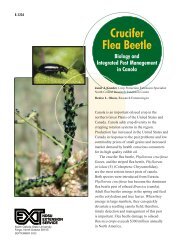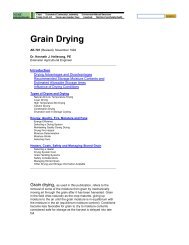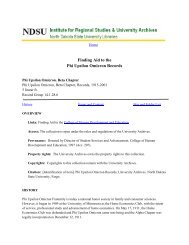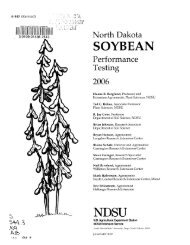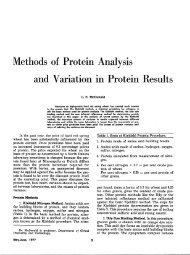Fertilizing Field Pea and L...
Fertilizing Field Pea and L...
Fertilizing Field Pea and L...
- No tags were found...
You also want an ePaper? Increase the reach of your titles
YUMPU automatically turns print PDFs into web optimized ePapers that Google loves.
SF-725 (Revised 1998)D.W Franzen, Extension Soil Specialist<strong>Field</strong> pea <strong>and</strong> lentil are two legumes grown in the region as a high protein crop for livestock feed <strong>and</strong> human consumption.Acreage of field pea has increased recently, with the trend expected to continue as traditional wheat producers search forrotational crops that will decrease marketing risk, decrease the risk of certain diseases <strong>and</strong> insects, <strong>and</strong> increase the qualityof soil in their fields.Acreage of lentil remained stable from 1993 to 1996 at about 9,000 acres per year in North Dakota.Nitrogen requirement <strong>and</strong> inoculationAlthough some yield response of pea <strong>and</strong> lentil can be seen with high rates of nitrogen supplements, usually littleadditional nitrogen is required if the seed is treated with the proper inoculum. Inoculate lentil with the lentil strain ofRhizobium leguminosarum <strong>and</strong> field pea with the pea strain of Rhizobium leguminosarum. Studies have shown that from 60to 80% of the N in field pea comes from nitrogen fixation. The remainder may come from soil organic matter/residuemineralization or nitrogen fertilizer.In a soil fertility trial at Carrington in 1995, beginning soil test levels were 20 lb of NO 3 -N in the surface 0-2 foot depth.Treatments <strong>and</strong> results are detailed in Table 1.Table 1. Effect of inoculation <strong>and</strong> N rates on yield <strong>and</strong> protein of field pea.SeedProtein,%Yield,lb/acreYield, %of CheckTreatmentNo inoculum, 0 N 20.4 2064 100Nitrogin inoculum 20.6 2930 142Sowfast inoculum 21.0 2705 131Sowfast + 20 lb N/acre 20.6 2988 145Sowfast + 50 lb N/acre 19.5 3198 15590 lb/acre N only 19.0 3024 14635 lb/acre N only 18.4 2475 120Sowfast + 20 lb/acre N + 40 lb/acre 21.3 2981 144SulfurLSD 0.05 1.2 393 19Inoculation significantly improved yields. Differences between inoculation treatments were not significant. The 90 lb/acre Nrate gave yields similar to inoculated treatments.Generally, inoculation is less expensive than nitrogen fertilizer <strong>and</strong> supplemental nitrogen fertilizer would not beencouraged in most fields.
Phosphate fertilizer <strong>and</strong> placement<strong>Field</strong> pea <strong>and</strong> lentil respond to P fertilization. P rates depend on soil test levels <strong>and</strong> yield goals ( Table 2). Yield goals aredetermined by looking at past field histories, or if the crop is new to a production area, consulting with an agronomist or aproducer in the North Dakota <strong>Pea</strong> <strong>and</strong> Lentil Association may give some insight into what a practical yield expectation is.Table 2. Phosphorus (P) <strong>and</strong> potassium (K) recommendations for field pea <strong>and</strong> lentil.Soil test P, ppm----------------------------------------Soil test K, ppm-------------------------------------------VL L M H VH VL L M H VHYield BrayP10-5 6-10 11-15 16-20 20+Goal Olsen 0-3 4-7 8-11 12-15 16+ 0-40 41-80 81-120 121-160 161+lb/acre---------------lbP2O5/acre------------------------------lb K2O/acre---------------1400 20 15 10 0 0 35 25 15 0 01800 30 20 10 0 0 45 30 20 0 02200 35 25 15 0 0 55 40 25 10 02600 40 30 15 0 0 65 45 30 10 0Bray P1 recommendation=(0.01710-0.00085 STP) X YGOlsen P recommendation=(0.01710-0.0011 STP) X YGPotassium recommendations=(0.03000-0.00018 STK) X YGThe abbreviations used in the equations are as follows:YG=yield goalSTP=soil test PSTK=soil test KPhosphate may be broadcast, but increased yields have been seen when P is sideb<strong>and</strong>ed or b<strong>and</strong>ed with the seed. Whenfertilizing in a b<strong>and</strong> application, the amount of P recommended at very low (VL) <strong>and</strong> low (L) soil P levels can be decreasedby one-third. At medium or higher levels, P rates should remain as shown in Table 2.The limit to P fertilizer applied in the seed b<strong>and</strong> is about 20 lb /acre P 2 O 5 as MAP (monoammonium phosphate, alsodesignated as 11-52-0, or 10-50-0). DAP (diammonium phosphate, also designated 18-46-0) is often too "hot" forgerminating pea <strong>and</strong> lentil seeds <strong>and</strong> young seedlings, so it should be avoided, as should other nitrogen containingfertilizers. MAP, although it contains nitrogen, is somewhat safer, because when it dissolves, it produces lower amounts offree ammonia than other fertilizers.Canadian recommendations limit the source of seed b<strong>and</strong>ed P to MAP, <strong>and</strong> also recommend that rates be kept at a limit ofabout 40 lb/acre of MAP, or about 20 lb/acre P 2 O 5 . Recent work at Carrington verifies these previously observedcharacteristics in a double-disc drill placement study (Table 3).Table 3. Effect of seed-placed fertilizers on field pea st<strong>and</strong>s usingdouble-disc drill placement with 7-inch row spacing.Treatment <strong>Pea</strong> plants/acre X 1000 Yield, bu/acreUntreated check 313.0 67.820 lb/acre P 2 O 5 , MAP 267.4 68.340 lb/acre P 2 O 5 , MAP 239.0 64.220 lb/acre P 2 O 5 , DAP 256.1 69.440 lb/acre P 2 O 5 , DAP 199.2 64.2LSD 0.05 7.2 NS
Spreading out fertilizer with an air-seeder drill attachment may further safen seed placed application through dilution;however, rates of phosphate should be kept no higher than the levels recommended in Table 2.Potassium, sulfur <strong>and</strong> other nutrientsIf soil test levels of potassium are low, addition of potassium fertilizer would be recommended as shown in Table 2. Mostfields in North Dakota are high in K, so the probability of response would be very low. Areas lower in K would tend to bes<strong>and</strong>y soils in higher l<strong>and</strong>scape positions.Sulfur deficiencies on field pea have been observed in North Dakota on s<strong>and</strong>y, eroded hillsides <strong>and</strong> hilltops under loworganic matter conditions. These areas may respond to sulfur fertilizer if treated with a soluble form of sulfate supplyingfertilizer. Elemental sulfur products are not generally effective in the first year of application due to a slow microbialconversion to sulfate. Treatment of entire fields with sulfur would only be recommended on low organic matter fields withlow sulfur soil test levels.No reports of responses of lentil <strong>and</strong> field pea to iron, copper, zinc, chloride, manganese or boron have been reported inNorth Dakota. These crops are either not sensitive to low soil levels of these nutrients, or levels of these nutrients aresufficiently supplied by the soil for these crops.SF-725 (Revised 1998)County Commissions, North Dakota State University <strong>and</strong> U.S. Department of Agriculture cooperating. North Dakota State University does notdiscriminate on the basis of race, color, national origin, religion, sex, gender identity, disability, age, status as a U.S. veteran, sexual orientation, maritalstatus, or public assistance status. Direct inquiries to the Vice President for Equity, Diversity <strong>and</strong> Global Outreach, 205 Old Main, (701) 231-7708. Thispublication will be made available in alternative formats for people with disabilities upon request, 701 231-7881.Information for Prospective StudentsNDSU is an equal opportunity institutionThis information may be photocopied for noncommercial, educational purposes in its entirety with no changes.Requests to use any portion of the document should be sent to NDSU.permission@ndsu.edu.North Dakota State University Agriculture <strong>and</strong> University ExtensionDept. 7070, Morrill 7, P.O. Box 6050, Fargo, ND 58108-6050



